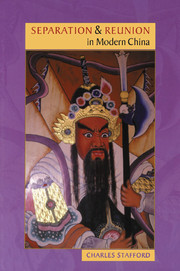Book contents
- Frontmatter
- Contents
- Acknowledgements
- Introduction: an anthropology of separation
- 1 Two festivals of reunion
- 2 The etiquette of parting and return
- 3 Greeting and sending-off the dead
- 4 The ambivalent threshold
- 5 Commensality as reunion
- 6 Women and the obligation to return
- 7 Developing a sense of history
- 8 Classical narratives of separation and reunion
- 9 The politics of separation and reunion in China and Taiwan
- Conclusion: the separation constraint
- Notes
- References
- Index
4 - The ambivalent threshold
Published online by Cambridge University Press: 22 September 2009
- Frontmatter
- Contents
- Acknowledgements
- Introduction: an anthropology of separation
- 1 Two festivals of reunion
- 2 The etiquette of parting and return
- 3 Greeting and sending-off the dead
- 4 The ambivalent threshold
- 5 Commensality as reunion
- 6 Women and the obligation to return
- 7 Developing a sense of history
- 8 Classical narratives of separation and reunion
- 9 The politics of separation and reunion in China and Taiwan
- Conclusion: the separation constraint
- Notes
- References
- Index
Summary
When various people – say friends, or honoured guests – arrive and depart in China, they of course must normally do so via ‘doors’. And while this seems perfectly natural, it has some intriguing implications, not the least of which is that doors themselves become very significant features of the Chinese social landscape. The Chinese word which is used to mean both ‘door’ (as in the door to a house or a room), and ‘gate’ (for instance the gate to a farmhouse compound or animal enclosure), is men. The same term also covers the many large and symbolically important public gates (or arches) found throughout China – such as the Gate of Heavenly Peace, Tian'anmen. It can in fact be argued that the symbolic centre of modern China, Tian'anmen, is not the famous square (gongchang) at the heart of Beijing, but rather the famous gate (men) which looks down upon it. For as Angela Zito has pointed out, imperial architecture (i.e. the architecture of imperial cities, palaces, and sacred sites in China) greatly emphasised not only walls, which served to delineate inside and outside (see also Hay 1994), but also gates which, as ‘mediating spaces’ (Zito 1997: 140), played a crucial role in imperial ritual activity:
The size and ornamentation of these massive gates far exceed anything called for by their mundane function. Beijing, containing as it did the Son of Heaven, ultimate source of wen, order, ‘civilization’, possessed the most impressive gates in the kingdom. The Outer City had ten, the Inner City eleven. The Imperial City and the Forbidden City walls each had four, one facing in each direction. Within, the doorways to all buildings were named and often marked with imperial calligraphy on the lintels.
(1997: 139; see also Bray 1997: 92–3)- Type
- Chapter
- Information
- Separation and Reunion in Modern China , pp. 87 - 98Publisher: Cambridge University PressPrint publication year: 2000



